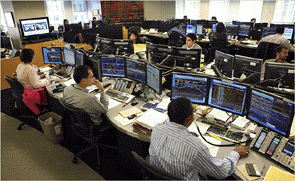
By Mike Burrrowes
NZD
NZD/USD skidded to a low of 0.7470 during the early evening as escalating fears over the European debt crisis hit risk sentiment. Comments from Federal Reserve Chairman Bernanke this morning helped risk sentiment recover and pushed NZD/USD back to 0.7500.
Despite the ructions offshore, local data outturns continue to suggest the NZ economy is expanding. Do we have our heads in the sand? Are we grossly underestimating the fall-out that is about to hit us from the deteriorating global environment? Has the Rugby World Cup clouded our vision? There’s probably an element of truth in all these factors. Nonetheless, yesterday’s October NZIER Quarterly Survey of Business Opinion fits well with our view that the New Zealand economy continues to hang together despite the global situation. Indeed, the forward looking indicators are entirely consistent with our belief that annual growth in GDP will be up around 3.0% by year’s end.
Overnight the latest on-line Fonterra auction saw a further 1.6% easing in average dairy prices. Thanks to a plummeting NZD, in local currency terms, average dairy price surged 7.5%. We again take encouragement from this result, given we were braced for the possibility of a larger decline, given the declines in other global commodity prices such as wheat -13%, corn -16%, sugar -8% and the fear saround world growth and the very strong start to the NZ milk season. There was little reaction in the NZD to the release.
NZD/AUD has gained steadily over the past 24 hours, rising from 0.7890 to 0.7960 currently. The move higher in the cross was driven by a dovish RBA statement yesterday (see Majors section below). This has seen the NZ-AU 3-year interest rate differential move sharply in the NZD’s favour, currently at -79bps from -94bps yesterday.
Looking to the day ahead, with no local data out, expect the NZD to take its cues from offshore. Across the Tasman, retail sales will be released at 1.30pm NZT. For the day ahead, initial support on NZD/USD is eyed at 0.7470 and resistance at 0.7550.
Majors
Trading in FX markets was more subdued overnight, relative to some of the large moves seen recently. Overall, the USD is modestly lower after risk sentiment recovered early this morning. AUD/USD was the worst performing currency after the Reserve Bank of Australia opened the door to rate cuts.
EUR/USD collapsed almost ¾ cents to 1.3150 early in the evening, its lowest level since January this year. The weakness was driven by a shock rise in Spanish unemployment for September (95.8k vs 42.1k expected). In addition, the share price of financial services firm, Dexia, fell 37% intra-day, but recovered to be ‘only’ 23% down for the day. Rating agency S&P added to the dour mood, noting the “prospect Europe might dip into recession is looking more likely”.
However, early this morning EUR/USD surged back above 1.3300 and is currently trading at 1.3250. The EUR spiked higher after US Federal Reserve Chairman Bernanke noted “the Fed [is] prepared to take further action as appropriate”. The whiff of QE3 was sufficient to help US equity markets pare earlier losses and push the USD lower across the board. The move higher also appeared to be exacerbated by short-sellers exiting their positions.
While EUR/USD recovered overnight, the currency still looks vulnerable to further declines. Indeed, expect fears of a ‘disorderly’ Greek default to remain as European political leaders have delayed a decision on the vital Greek aid payment until mid-October.
GBP/USD dropped to 1.5340 overnight, near its lowest level since December last year. The losses occurred after UK construction data for September was weaker-than-expected (50.1 vs. 51.6 expected). This outturn spurred speculation the Bank of England may resort to more quantitative easing at its decision on Thursday night. However, the majority of analysts expect the BoE to wait until November.
AUD/USD briefly fell to 0.9390 overnight, its lowest level since September 2010 and 17% off the post-float high reached in July. The weakness kicked-off after yesterday’s RBA statement. While the RBA left the cash rate on-hold at 4.75%, the accompanying statement opened the door to a near-term rate cut if global and domestic economic conditions worsen further. The OIS market is now pricing a 20% chance of a cut from the RBA at the next meeting and a total of 160bps of cuts over the next 12 months.
Looking to the day ahead, expect the focus to remain on the European debt crisis. On the data front, we have Eurozone PMI services and retail sales. In the UK, the final Q2 GDP is due for release along with PMI services and the current account. In the US, the highlights will be ADP employment and ISM non-manufacturing.
No chart with that title exists.
See our interactive swap rates charts here and bond rate charts here.
Mike Burowes is part of the BNZ research team.
2 Comments
"Regarding its review of its bank ratings criteria, Standard & Poor's in January said: "We expect the pattern of banking sector boom and bust and government support to repeat itself in some fashion, regardless of governments' recent and emerging policy responses." herald
Right now the banks are facing downgrades made more likely given the brown stuff is splattering the walls.
They will have to pay more for their loans which underly the credit they created and flogged off as mortgage money. Forget about Chickens coming home to roost, the fox is sniffing out the henhouse.
English and Bollard will be forced to follow Swann and Stevens in building in govt guarantees on bank deposits or risk the flight of capital across the ditch.
FED´s single mandate: Keep the mkt afloat
We welcome your comments below. If you are not already registered, please register to comment.
Remember we welcome robust, respectful and insightful debate. We don't welcome abusive or defamatory comments and will de-register those repeatedly making such comments. Our current comment policy is here.